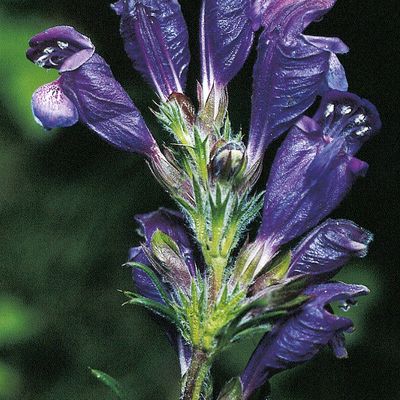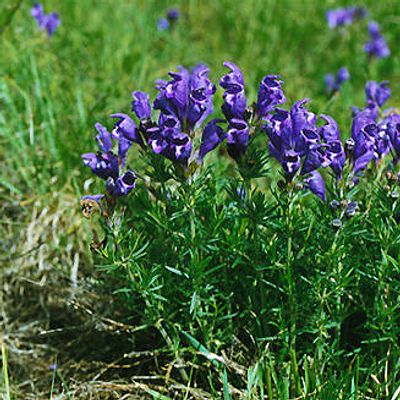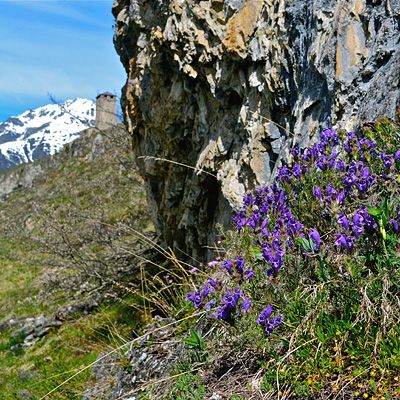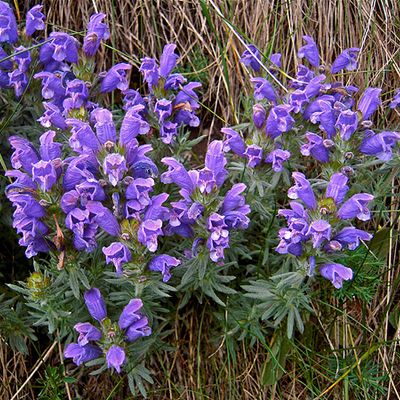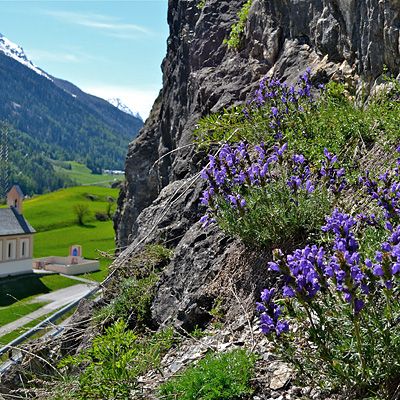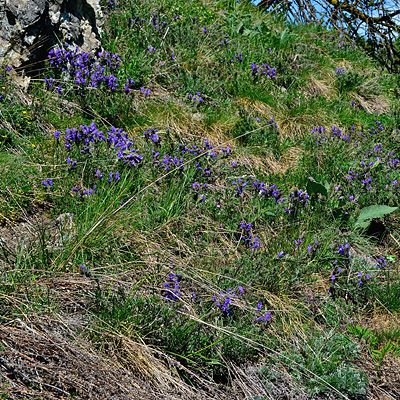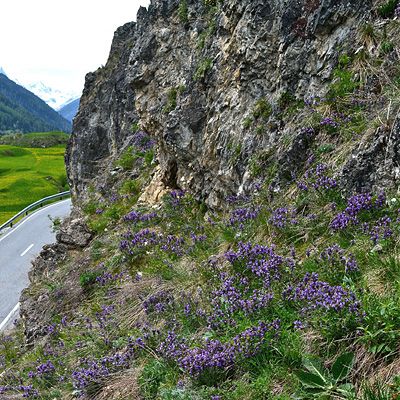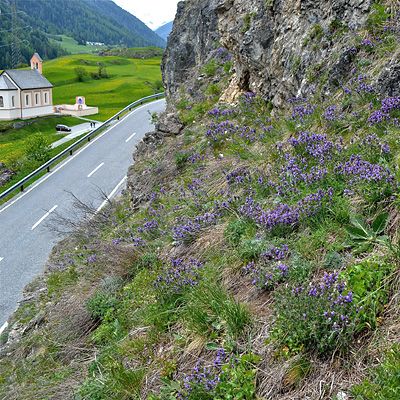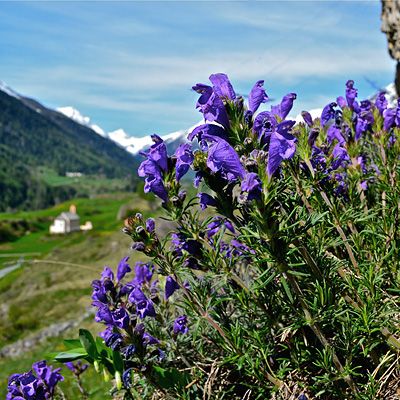Dracocephalum austriacum L.
1015790
Species
ISFS : 141700
Checklist : 1015790
ISFS : 141700
Checklist : 1015790
Contains :
Synthesis
Species description (© Flora Helvetica 2018)
Ähnlich wie D. ruyschiana, aber 20-40 cm hoch, Stängel dicht behaart, Blätter z.T. fiederschnittig, mit 3-7 schmal-lanzettlichen, 1-2,5 mm breiten Abschnitten, die quirligen Teilblütenstände 2-4blütig, Blüten 3,5-4,5 cm lang, dunkelviolett, mit 3teiligen, 3-8 mm langen Vorblättern (bei D. ruyschiana Vorblätter ungeteilt, 3-4 mm lang).Flowering period (© Flora Helvetica 2018)
5-6Habitat and distribution inside Switzerland (© Flora Helvetica 2018)
Felsige Hänge, Trockenrasen / kollin-subalpin / VS (unteres Rhonetal), GR (Unterengadin)World distribution (© Flora Helvetica 2018)
OsteuropäischEcological indicator (© Landolt & al. 2010)
153-42+5.h.2n=14Status
IUCN status
VulnerableNational Priority
3 - medium national priorityInternational responsibility
2 - mediumConservation
Threats
Bewirtschaftungsänderungen
Bautätigkeit (touristische Anlagen, Strassen, Leitungen)
Beweidung (v. a. Schafe)
Verbuschung, Verwaldung
Freizeitaktivitäten (Tritt)
Sammeln, Ausgraben
Distribution map
Habitat and distribution inside Switzerland
VS (unteres Rhonetal), GR (Unterengadin)World distribution
OsteuropäischEcology
Life form
Perennial hemicryptophyte
Habitats
Milieux Phytosuisse (© Prunier et al. 2017)
Habitats © Delarze & al. 2015
 | 4.2.1.1 - Inneralpine Felsensteppe (Stipo-Poion) |
bold
Dominant species, influencing the appearance of the habitat
 Character species
Character species
 Less strictly linked to a specific habitat
Less strictly linked to a specific habitat
Ecological indicator values by © Landolt & al. (2010)
| Soil factors | Climatic factors | Salinity tolerance | |||
|---|---|---|---|---|---|
| Humidity Value H | 1 | Light Value L | 4 | Salinity Index | -- |
| Reaction Value R | 5 | Temperature factor T | 2+ | ||
| Nutriments value N | 3 | Continentality K | 5 | ||
- Ecological values legend
Humidity Value H 1 very dry 1+ dry 2 moderatly dry 2+ moist 3 medium wet 3+ wet 4 very wet 4+ soggy 5 submerged or underwater f plants living in running water u mostly submerged plants v partly submerged, partly floating plants w humidity moderately variable (± scale of 1-2) w+ highly variable humidity (scale exceeding ± 2) Reaction Value R 1 Very acid (pH 2.5-5.5) 2 acid (pH 3.5-6.5) 3 lightly acid to neutral (pH 4.5-7.5) 4 neutral to basic (pH 5.5-8.5) 5 basic (pH 6-5 -> 8.5 Nutriments value N 1 very low in nutrients 2 low in nutriments 3 medium-poor to medium-rich in nutrients 4 rich in nutriments 5 very rich in nutriments Salinity tolerance 1 halotolerant 3 halophyle Light Value L 1 very shady 2 shady 3 lighted areas 4 luminous 5 highly luminous Temperature factor T 1 alpine to nival stages (from the treeline to the snowline) 1+ suprasubalpine and upper subalpine levels (pine and larch forests) 2 subalpine level (coniferous forests without beeches up to the upper limit of spruces) 2+ lower subalpine and upper mountain stages 3 mountain level (beech and silver fir forests, in the central Alps Scots pine forests) 3+ lower mountain and upper hill levels 4 hill level (mixed deciduous oak forests) 4+ hot places, hill level 5 very hot places, hill level (only in the hottest places, typical of southern Europe) Continentality K 1 Atlantic (high air humidity, very low temperature variations, mild winters) 2 Sub-Atlantic (high air humidity, low temperature variations, relatively mild winters) 3 sub-Atlantic to subcontinental (average air humidity, moderately variable temperature, slightly low winter temperatures) 4 subcontinental (low air humidity, large temperature variations, rather cold winters) 5 continental (very low air humidity, very large temperature variations, cold winters)
Water dependency
| Rivers | 0 - No link |
| Calm water | 0 - No link |
| Ground water | 0 - No link |
Nomenclature
Accepted Name (Checklist 2017)
Dracocephalum austriacum L.
Vernacular name
Deutscher Name :
Österreicher DrachenkopfNom français :
Tête de Dragon d'AutricheNome italiano :
Melissa austriacaMatch with other reference books
| Relation | Nom | Book | No |
|---|---|---|---|
| = | Dracocephalum austriacum L. | Checklist 2017 | 141700 |
| = | Dracocephalum austriacum L. | Flora Helvetica 2001 | 1644 |
| = | Dracocephalum austriacum L. | Flora Helvetica 2012 | 1592 |
| = | Dracocephalum austriacum L. | Flora Helvetica 2018 | 1592 |
| = | Dracocephalum austriacum L. | Index synonymique 1996 | 141700 |
| = | Dracocephalum austriacum L. | Landolt 1977 | 2492 |
| = | Dracocephalum austriacum L. | Landolt 1991 | 2024 |
| = | Dracocephalum austriacum L. | SISF/ISFS 2 | 141700 |
| = | Dracocephalum austriacum L. | Welten & Sutter 1982 | 1413 |
= The taxon corresponds to the accepted taxon (Checklist 2017)
< The taxon is included in the accepted taxon (Checklist 2017)
> The taxon includes (among others) also the accepted taxon (Checklist 2017)
< The taxon is included in the accepted taxon (Checklist 2017)
> The taxon includes (among others) also the accepted taxon (Checklist 2017)
Status
Native status
-IUCN list of endangered species (© Walter & Gillett 1997) : No
Status on national Red List 2016
IUCN status:
Vulnerable

Additional information
IUCN criteria: C1; C2a(i)
Status on regional Red List 2019
| Biogregraphic regions | Status | IUCN criteria |
|---|---|---|
| Jura (JU) | -- | |
| Mittelland (MP) | -- | |
| Alpennordflanke (NA) | -- | |
| Alpensüdflanke (SA) | -- | |
| Östliche Zentralalpen (EA) | VU | C1; C2a(i) |
| Westliche Zentralalpen (WA) | VU | C1; C2a(i) |
- Legend
EX Extinct RE Regionally Extinct CR(PE) Critically Endangered, Probably Extinct CR Critically Endangered EN Endangered VU Vulnerable NT Near Threatened LC Least Concern DD Data Deficient NE Not Evaluated NA Not Applicable
National Priority Species List Status
| National Priority | 3 - medium national priority |
| Need to take action | 2 - |
| International responsibility | 2 - medium |
| Need to monitor populations | 2 - |
Protection status
| International (Bern Convention) | Yes | |
| GR | total protection | (01.12.2012) |
| Switzerland | total protection |
- Disclaimer
InfoFlora compiles information on protected species as accurately as possible, taking it from the respective cantonal laws. In some cases, however, it was not possible to use the plant names as listed in the original text, but an interpretation of their taxonomy or nomenclature was necessary. The exact meaning of the categories „completely protected“ and „partially protected“ differs among the cantons.
InfoFlora cannot guarantee that the information on the protection status is correct and complete. In case of doubts, we recommend to look up the texts of the respective cantonal law.
Status by sector of activity
| Agriculture-related environmental objectives : | more informations | |
| Forest management environmental objectives : | more informations |
Conservation
Threats and measures
Bewirtschaftungsänderungen
Extensive Nutzung der Wiesen gewährleisten (keine Düngung und Bewässerung, weiterhin einmal pro Jahr mähen)
Bautätigkeit (touristische Anlagen, Strassen, Leitungen)
Priorität für die Art bei Planung allfälliger Bauvorhaben
Beweidung (v. a. Schafe)
Reduktion des Weidedrucks in intensiv genutzten Bereichen (z. B. Steinisberg bei Ardez)
Kontrolle der Beweidung in allen Fundgebieten
Verbuschung, Verwaldung
Entbuschen
der Ausdehnung des Waldes entgegenwirken (z. B. tiefere Stellen bei Vertsan Dessous)
Freizeitaktivitäten (Tritt)
Zusätzliche Trampelpfade vermeiden
keine Picknick-Plätze anlegen
Sammeln, Ausgraben
Pflanzenschutzgebiete einrichten
Hinweistafeln zu Sammelverbot
